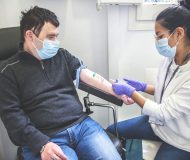

International collaboration led by researchers at the Sant Pau Reseach Institute – IIB Sant Pau in Barcelona, Spain, shows effectiveness of a plasma biomarker to detect Alzheimer’s Disease in Down syndrome individuals. Their results, which have been published in Nature Communications, will enhance diagnostic capability in this particular population. In parallel, researchers have also published another study in JAMA Neurology where they analyzed the influence of the most important genetic factor for Alzheimer’s disease (APOE) on the mechanisms of this pathology in the population with Down syndrome
Scientists worldwide are immersed in the race for accurate, non-invasive and accessible biomarkers to detect and diagnose Alzheimer’s Disease. To date, major scientific advances allowed the identification of several biomarkers in cerebrospinal fluid or using positron emission tomography (PET). Yet, these methods are expensive, invasive and not accessible so they are not included in clinical routine and only restricted to a few.
Most recently, blood biomarkers have emerged as an easy and cost-effective alternative for the screening of Alzheimer’s disease. One of these new plasma biomarkers is protein p-tau 181, which was firstly described as potential biomarker by scientists at the University of Gothenburg.
Now, researchers at the Hospital de Sant Pau Research Institute – IIB Sant Pau in Barcelona in collaboration with scientists at University of Gothenburg and University of Montpellier, assessed the accuracy of p-tau 181 in plasma to detect Alzheimer’s disease in Down Syndrome individuals. As reported in Nature Communications, they have studied suitability and effectiveness of this biomarker in a cohort of 400 people, 366 of whom are adults with Down syndrome.
“In our study, we found that this biomarker actually works to detect Alzheimer’s among people with Down syndrome too. Discerning cognitive impairment in people who already have an intellectual disability or other dementias is difficult, and having biological markers available will improve our ability to diagnose”, says Dr. Albert Lleó, head of the Dementia Neurobiology Group at IIB Sant Pau and director of the Memory Unit of the Neurology Service at the Hospital de la Santa Creu i Sant Pau. “It is an important milestone to us because it will allow us to make early detection and provide appropriate care and treatment to address the progression of the disease”.
Down Syndrome and Alzheimer’s disease, a tandem to consider
Alzheimer’s disease is currently the leading medical problem for adults with Down syndrome and it is also the leading cause of death. Down syndrome is a condition in which a person has three copies of chromosome 21, which also led to have an additional copy of the amyloid precursor protein (APP) gene, making these people, therefore, much more likely to suffer Alzheimer’s disease.
IIB Sant Pau’s team, which has long experience and is an intenational benchmark in the relationship between Alzheimer’s disease and Down syndrome, includes the Alzheimer-Down unit, led by Dr. Juan Fortea. This pioneering unit, resulted from a collaboration between the Catalan Down Syndrome Foundation and the Hospital de la Santa Creu i Sant Pau.
“Understanding the pathophysiology of Alzheimer’s disease and being able to have tools for early diagnosis becomes even more relevant when we talk about people with Down syndrome”, says Juan Fortea, head of the Alzheimer-Down unit.
Deepening the mechanisms of Alzheimer’s to understand its progression
Also, researchers Florencia Iulita and Alexandre Bejanin from this unit have studied the pathophysiological processes involved in the development and progression of Alzheimer’s in Down syndrome individuals.
Researchers have focused on a particular gene encoding for the apolipoprotein APOE ɛ4, which is associated with an increased risk of Alzheimer’s. In their study, recently published in JAMA Neurology, they characterized the association of this gene with various Alzheimer’s biomarkers and segmented it by age groups of study. The main findings show that the risk of Alzheimer’s is much higher in people with Down syndrome and to what extent this risk increases with age. The study also provides information on the mechanisms by which this happens
“We believe that our work comes timely considering the large number of studies available related to the prevention and diagnosis of Alzheimer’s disease. Considering genetics and the APOE genotype may be important when designing new drugs and clinical trials”, concludes Dr. Fortea.
Advancing Alzheimer’s research from many different angles
These two works highlight the relevance of multidisciplinarity when addressing neurodegenerative diseases. IIB Sant Pau’s team approached Alzheimer’s disease from many angles and the team includes experts in neurology, neuropsychology, biology, engineering, nursing and research. They tackle several research projects aimed at improving diagnosis, at better understanding the disease and its progression, as well as at identifying therapeutic targets while improving the clinical care of patients and their caregivers.
Papers cited